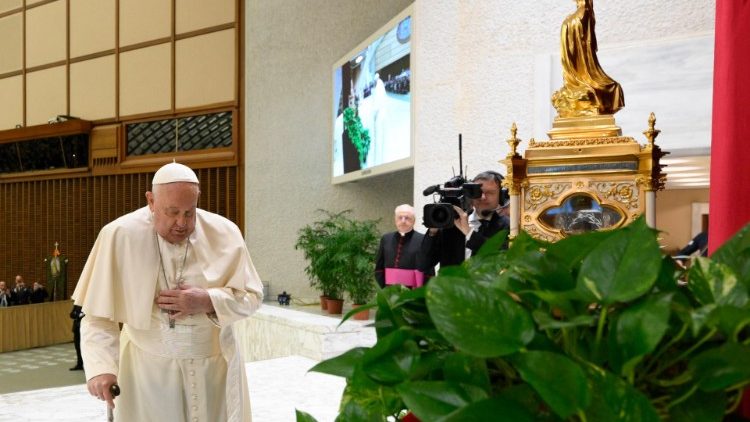Pope Begins Catechesis Tied to Jubilee: “Jesus Christ, Our Hope”
With the opening of the Holy Door just days away, Pope Francis holds his weekly General Audience and begins the cycle of catechesis that will define the entire Jubilee Year, focusing on "Jesus Christ, our hope."

As the countdown to the Jubilee draws near, Pope Francis began a new cycle of catechesis specifically inspired by the Holy Year. This new cycle, which will unfold throughout the Jubilee, centers around the theme “Jesus Christ, our hope.”
Two Gospels, One Story
In light of this new focus for the General Audience catechesis, the Pope described Jesus as “the goal of our pilgrimage, and He Himself is the way, the path to follow.” This cycle will be broken down into various parts, beginning with the childhood of Jesus, inspired by the Gospels of Matthew and Luke.
Reflecting on these Gospels, the Pope explained that they “recall the messianic prophecies” fulfilled with the birth of Jesus and his lineage throughout the Old Testament. While both evangelists present the infancy and childhood of Jesus, there is one unique difference.
“Luke tells the events from the perspective of Mary,” Pope Francis described. “Matthew does so from the perspective of Joseph, emphasizing a fatherhood that is so unique.”
An Ancient DNA Test
The Gospel of Matthew begins by tracing Jesus’ genealogy from Abraham to Joseph and Mary. It becomes a list of names that are “meant to show the truth of history and the truth of human life.”
The climax of the ancestry of Jesus is his birth, as “everything ends and flourishes in Mary and Christ.” Listing all the names demonstrates the “truth of human life passing from one generation to the next.”
Each name signifies a new chapter. Each name “encapsulates a unique identity and mission; membership in a family and a people; and, finally, the faith adherence to the God of Israel.”
 A Special Genealogy
A Special Genealogy
Among the various literary genres found in the Gospels, the genealogy conveys an essential message: “No one gives life to themselves, but rather receives it as a gift from others.”
Jesus’ family tree follows the people and families who make up the chosen people of God and pass on the faith of their fathers to the next generation.
Yet, the genealogy in the New Testament has a striking difference to those found in the Old Testament. The names of five women are also listed: Tamar, Rahab, Ruth, Bathsheba, and Mary of Nazareth. Pope Francis explained that the first four are united “not by the fact that they are sinners… but by the fact that they are foreigners to the people of Israel.”
As Pope Benedict XVI wrote, Matthew’s Gospel highlights that through the Gentiles, Jesus comes into the world. “His mission to both Jews and Gentiles becomes visible.”
Mary: The Woman Who Stands Out
The final woman mentioned in the genealogy is Mary, the mother of Jesus. Unlike the previous four, she is not listed “alongside the man born of them or the one who fathered them.”
The Pope clarified that this shows that “she marks a new beginning” because her story illustrates that “the human creature is no longer the one who generates, but God Himself.”
A Birth for All People
When Jesus is listed, the term “is born” is used. Pope Francis reflected on this term, saying his birth was meant for both Jews and non-Jews alike.
As Jesus is the son of King David, he is “grafted by Joseph into that dynasty and destined to be the Messiah of Israel.” Yet, he is also the son of foreigners, so he is “destined to be the ‘Light of the Gentiles.’”
The Pope ended by calling everyone to “awaken in ourselves a grateful memory toward our ancestors” and to thank God, “who, through the mother Church, has generated us to eternal life, the life of Jesus, our hope.”
 Flowers in Front of the Golden Reliquary of St. Thérèse of the Child Jesus
Flowers in Front of the Golden Reliquary of St. Thérèse of the Child Jesus
At the beginning of the Audience, Pope Francis venerated the relics of St. Thérèse of the Child Jesus by offering a bouquet of flowers.
Kept in a golden reliquary, they will remain in Rome at the Church of Trinità dei Monti near the Spanish Steps throughout the Jubilee Year.
Related

The Pope to the Missionaries of Mercy: God became man to reveal to the world that he never abandons us!
Exaudi Staff
30 March, 2025
2 min

God’s Mercy and the Call to Peace in Pope Francis’ Angelus
Exaudi Staff
30 March, 2025
3 min

Pope Francis Improves and Prays for Myanmar Earthquake Victims
Exaudi Staff
28 March, 2025
1 min

Five Years After Statio Orbis: Hope in the Midst of the Storm
Exaudi Staff
27 March, 2025
2 min
 (EN)
(EN)
 (ES)
(ES)
 (IT)
(IT)

